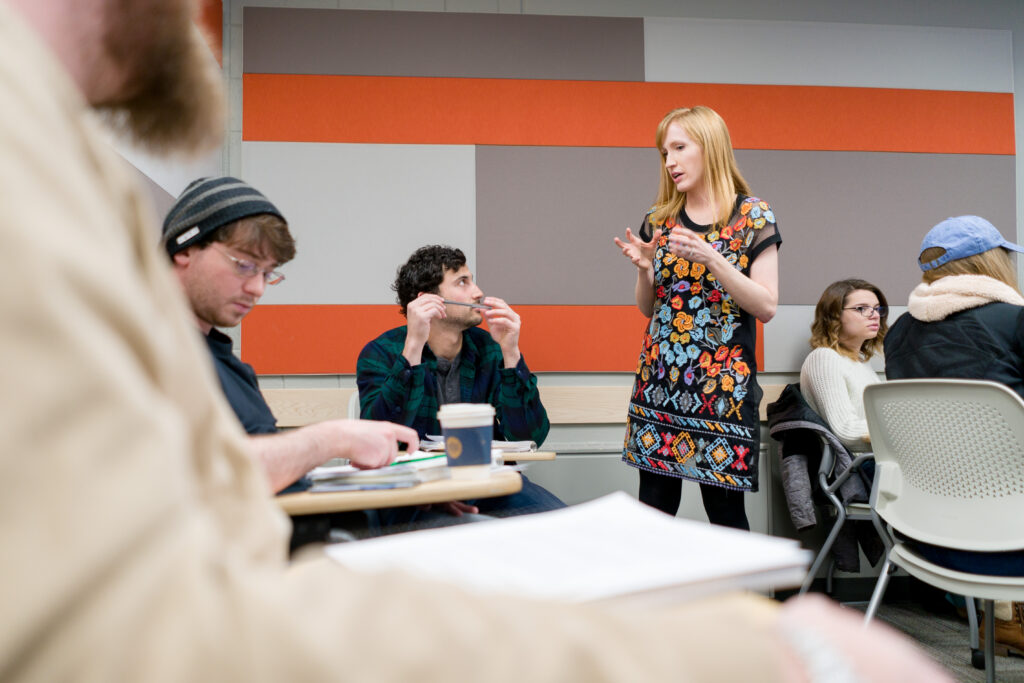Active Learning
Students benefit from a classroom structure that includes planned and purposeful opportunities to engage with content and each other. The following list includes a few considerations when planning for active learning:
- Use a variety of teaching methods and modalities (verbal, interactive, Socratic, etc.) that align with learning objectives

- Use Think Pair Share to engage students, break up lecture, or check for student understanding
- Engage students in Community Engaged Learning that meets academic and community needs
- Grab students’ attention during the First five minutes of class; finish strong in the last five minutes
- Individual processing activities
- Partner processing activities
- Small group activities
- Use learning strategies that have a proven effect size on student learning
- Concept maps
- Use discussion techniques – small group, discussion protocols, think pair share, fishbowl, CATS, etc.

- Host online discussions in the Canvas LMS
- Use classroom management strategies – set a timer for activities, write and post directions for activities
- Chunk class time into 10 – 15 minute segments with processing time after each segment
- Service learning
- In-class problem solving – Problem Solving Models
- Promote deep learning and problem solving with case studies: (science case studies)
- Support content retention and critical thinking with Writing Across the Curriculum activities
- Support deep understanding of concepts with peer-to-peer instruction
- Cultural learning projects
Hattie's Synthesis: Instructional Practices with High Effect Size
Professor John Hattie’s research has informed teaching for over twenty years. His research includes a meta-analysis of over 132,000 studies and over 300 million students. Below are instructional strategies that have a proven positive effect size on student learning:
- Use the Jigsaw Method for peer learning
- Give students the opportunity to be the expert with Reciprocal Teaching
- Reverse the traditional order of teaching with Inductive Teaching
- Provide graphic organizers to students to support student understanding or promote the use of graphic organizers in student notes
- Provide support, clarity, and structure to students by scaffolding learning and assignments
- Prime students for learning by activating prior knowledge
- Help students organize knowledge with concept mapping, (student directions)
- Add structure to collaborative learning for successful groupwork
- Enhance critical thinking with Problem Solving Teaching or Problem based Learning
Outside of class content processing techniques (homework)
- Authentic assignments: Ask students to do something closely related to how they will use their new knowledge in the real world. (In this video [7:26], the instructor provides examples for the students to prepare them for problems that the students will need to solve as part of the homework assignment.)
- Group assignments
- Writing assignments, wikis and blogs: Allow students to express curiosity, practice skills, process information, problem solve, and think critically.
- Conduct research
- Video presentations
- Service-Learning
- Student-generated study guides or quiz and exam questions

Additional Considerations for Teaching Online
While most of the information on teaching effectiveness pertains to both RI and online classrooms, following are a few key points for online courses.
- Not everything in your online course needs to be active. Readings and short lectures have their uses. But strategically including some active learning helps increase student motivation, and, in turn can improve students’ understanding. For example, you might intersperse readings and short lectures with games, activities and short assignments.
- It is important to keep in mind that many students take online classes because they have full-time jobs or military or family obligations that prevent them from being available at certain times. While much group work can take place asynchronously, some tools such as chats or Web conferences which are synchronous can be more difficult to manage across different time zones of your students. This isn’t to say you should never incorporate synchronous learning online, but be considerate of the reasons that students take online courses. Use synchronous learning sparingly, communicate any requirements well in advance, and be prepared to offer alternatives to students who do not have flexible schedules.
- A common fear is that the online classroom doesn’t lend itself to active learning in the same way that the RI classroom does. While it may look a little different or be asynchronous, you can use active learning in your online course just as you would in your RI course. A few ways to incorporate active learning in the online classroom are included below, but the list goes on. In short, you can do nearly everything online that you can in the classroom—you just might have to make a few tweaks to get there!
- Active Learning Strategies by Instructional Modality
- Chats
- Synchronous discussion in breakout rooms
- Short lectures interspersed with quizzes
- Let your students know which tools you will use for Communications.
- Establish an instructor audio/video presence in your course
- Set communication norms/expectations
- Authentic assignments. (In this video [15:00], the instructor and a helper play the roles of therapist and client. Students are asked to critique the therapist’s strengths and areas for improvement in a discussion forum.)

